Opinion: Why Is Dry Tooling Getting So Popular? It’s Awesome
This article originally appeared on Climbing
It's a rainy day in western Washington, typical for November. Between changing my 8-month old's diapers and a busy work schedule, my time is limited, and I don't want to waste a precious free day of climbing. The only problem? There is no dry rock within two hours of my house, and the fickle ice in the Cascades hasn't formed yet. Not wanting to spend another day stuck inside the bouldering gym, a lightbulb goes off in my head: it's time to go dry tooling at Wayne's World, a newly developed crag just 30 minutes outside of Seattle in North Bend, Washington.
Rain or shine, sleet or hail, dry tooling is accessible no matter the time of year. With more and more crags being developed, fewer crowds than most rock-climbing cliffs, and a season that runs year-round, it's no surprise (to some of us, anyway) that dry tooling is on the rise.

Dry tooling isn't just for reaching ice
"The idea of climbing with tools on rock seemed completely insane 25 years ago," professional climber, dry tooling expert, and all-around crusher Will Gadd told me over the phone. What started out as a way to get to ice climbs, has become a discipline of climbing in itself. The sport now has specific gear such as dry tooling boots with built in front points and more durable picks than those used for ice climbing. There is an international competition for dry tooling (though technically called the UIAA Ice Climbing World Tour, the nine competitions during the 2022/2023 season all involve climbing on artificial structures, with very little actual ice climbing). There are even gyms dedicated specifically to dry tooling (check out The Ice Coop in Boulder, Colorado), and many rock climbing gyms now set routes exclusively for dry tooling.
But there's another reason dry tooling is taking off: It's a lot of fun. Who doesn't like wielding sharp objects, slotting thin metal edges into tiny fissures, or making improbable moves like the Stein Pull or figure four?
There's also a certain element of problem solving involved in dry tooling. "It's hard to find out how to make it work. It's hard, so it's interesting," Gadd said.
The sport's intricate movement and technical nature requires its practitioners to develop a unique set of skills. But once these skills are honed, the tools literally come to feel like extensions of your body, giving extra reach, harnessing powerful bi-directional forces, allowing you to make unlikely moves that would be impossible on a pure rock climb.
Dry tooling is accessible
As climate change races forward, the ice climbing season is in many places becoming less predictable and, alas, shorter. Dry tooling is something climbers can do without relying on cold temperatures, though Gadd stressed that ice climbing and dry tooling are two very different sports. "In the public eye it's the same but they are completely different things." And just because you know how to use tools, he said, doesn't mean the skills are transferable across the disciplines.
It's also safer. While ice climbing is reliant on wintery conditions and often involves traveling into avalanche terrain, dry tooling has relatively little risk (most hard dry tooling routes are basically sport climbs) and their approaches are generally much more straightforward.
One of the keys to the growth of dry tooling is the tremendous potential for route development. There is rock everywhere, from Kansas to Saskatchewan, but that doesn't mean all rock is sufficiently high quality for rock climbing. But drytooling, rock climbing's stepchild, is not so picky. "There's [a seemingly] unlimited supply of rock out there that is great for dry tooling," Gadd said.

The future of dry tooling is man made
While the future of dry tooling is bright, the ceiling for hard dry tooling on natural rock may have been reached. From a physics standpoint, there is a limit to what the equipment of the sport i.e. the tools and front points can edge on without popping off. Gadd believes that outdoor dry tooling grades will become harder based on pushing the limits of endurance rather than the difficulty of individual moves. And since there just aren't that many natural climbs that are both humanly possible and harder than anything yet done by a human, Gadd sees the future of dry tooling in competition climbs and climbing on man-made structures.
These manufactured routes often involve "big spans where you cut loose and swing on flat roofs," Gadd explained. The rising popularity of dynamic routes--routes with features that physically move and swing as you move around on them--adds a new challenge that doesn't much resemble the moves found on a static piece of rock.
It's challenges like this that get Gadd excited and convince him that the sport of dry tooling has a bright future. "Who would have thought 25 years ago that this is where it would lead," Gadd reflected. A dynamic sport that you can do in the rain, all year round, anywhere in the world?
I'm on board.
Out at Wayne's World, I'm reminded (for the hundredth time) why I love climbing. The shady crag, tucked away from the traffic noise of Interstate 90, feels like a learning ground for all. There are three parties climbing here, and their excitement is palpable, almost like we were discovering a new way of climbing (which some of us were), in a secret location, and getting away with it. Climbers are passing tools with dry rated pics to climbers who only have ice rated pics on their tools. I love the movement and the challenge of climbing routes in a style that feels so familiar, yet so different. Dry tooling that day was scary, engaging, safe, technical, social, and fun--all mixed into one.
And that's how climbing should be.
For exclusive access to all of our fitness, gear, adventure, and travel stories, plus discounts on trips, events, and gear, sign up for Outside+ today.

